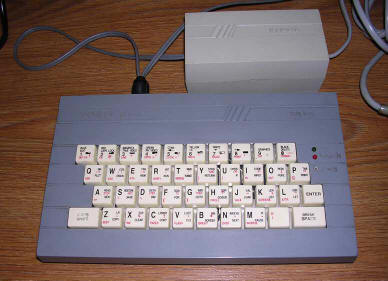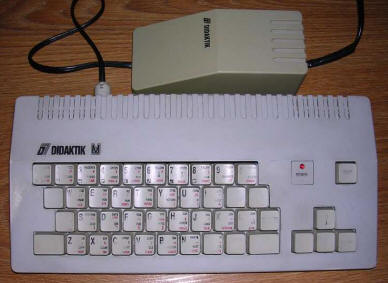Didaktik Gama
It was a small Czechoslovak home computer. First,
engineers in Didaktik Skalica (company known of producing teaching aids)
tried to make an old Tesla PMD-85 computer faster and better. First two
versions of Didaktik were clones of Tesla PMD-85 Intel-based computers
with better hardware and keyboard - because small keys in PMD were too
small to do any serious thing.
Didaktik Gama was the first clone of ZX Spectrum in Didaktik series, but
it was equipped with 80kB of RAM switchable by manufacturing-selected
address. It was really hard to get this computer - first units had to be
sold to schools, desperately looking for something better than
constantly overheating PMDs. More, it was very expensive - more
expensive than Delta (nothing to do with Didaktik naming, just Czech
rebranding to avoid western embargo) ZX Spectum Plus. Why so expensive?
First, manufacturing was very slow and gave many damaged units (which
were diagnosed and fixed or working components were desoldered to be
mounted in another unit). Second thing was a parallel interface (8255)
inside and more memory. In Eastern block, you could use Soviet or
western memory circuits. Soviet ones needed extensive testing before
they were accepted, because some got errors shortly after manufacturing, western ones were more expensive, but tests could be
avoided.
| Manufacturer | Didaktik Skalica | |
| Origin | Czechoslovakia (Slovakia) | |
| Year of unit | 1989 | |
| Year of introduction | 1987 | |
| End of production | 1992 | |
| CPU | Z80A | |
| Speed | 3.5MHz | |
| RAM | 80K (16+32+32K) | |
| ROM | 16K (BASIC) | |
| Colors: | 8 | |
| Sound: | 1-bit speaker | |
| OS: | Basic similar to Sinclair. | |
| Display modes: | Text: 32x24 Graphics: 256x192 |
|
| Media: | External Tape recorder | |
|
Power supply: |
||
|
Female 5-pin DIN at the computer: |
||
| I/O: | Parallel interface Expansion system bus RF modulator Monitor output Tape recorder socket (with power socket) |
|
| Possible upgrades: | Some (from Spectrum) known. | |
|
|
||
| Software accessibility: | Difficult (A few sites, but ZX Spectrum programs work) |
My unit has been traced to private buyer, not a school.
Personally, I like its case and ergonomy of keyboard - big, visible
square keys with documented functions. Unfortunately as you press the
keys it's not so good - you don't know you pressed it or not, it doesn't
go deep into the unit.
Didaktik M
Next Didaktik was more reliable and advanced computer,
with a new case and keyboard with separate arrows. It had only 48K of
memory (64K installed, but last 16K not accessible), smaller than Didaktik M, and had no parallel interface. Instead
of it, engineers added Kempston and Sinclair joystick ports, but their
pinouts were not compatible with anything.
Technically, engineers tried to make Didaktik cheaper. Instead of
expensive ULA circuit they used Soviet Angstrem Т34ВГ1
(export version labeled ULA1) substitute, giving
slightly different picture than in ZX Spectrum (aspect ratio was closer
to 1:1 instead of 4:3). This circuit, tested in Kompas / Компас computer,
had better thermal cycling stability than ULA, but only in DIP package -
SMD version had poor thermal design, giving many internal thermal
expansion forces prying connections from chip module.
| Manufacturer | Didaktik Skalica | |
| Origin | Czechoslovakia (Slovakia) | |
| Year of unit | 1992 | |
| Year of introduction | 1990 | |
| End of production | 1992 | |
| CPU | Z80 | |
| Speed | 4MHz | |
| RAM | 48kB (64K installed) | |
| ROM | 16K (Basic) | |
| Colors: | 8 | |
| Sound: | 1-bit speaker | |
| OS: | Basic (Sinclair-like) | |
| Display modes: | Text: 32x22 Graphics: 256x192 Display a bit different than in Speccy - Soviet Angstrem used instead of ULA chip. |
|
| Media: |
Tape recorder External FDD (thru system bus) |
|
|
Power supply: |
||
|
7-pin DIN female at the computer: |
||
| I/O: | Expansion bus Sinclair Joystick Kempston Joystick port Monitor output RF out Tape connector |
|
| Possible upgrades: | Not known | |
|
|
||
| Software accessibility: | Difficult (a few sites, Spectrum software works) |
My unit comes from school. It has been used so much that letters on keys are worn out. Moreover, its Angstrem is in plastic-molded SMD case, so the computer has its caprices - it sometimes hangs or changes colors. A light knock in case, near Angstrem restores a good situation.
| Contents: | Starting | Revisions | Connecting Peripherals | Links |
Starting:
These are almost Spectrum computers. They behave like Spectrum, so everything is like in Speccy. These computers should run many Spectrum programs well.
Tape creating is also like in Speccy.
Revisions:
There were a few revisions of Didaktik Gama computers.
- The first one, black, called Gama '87, was so buggy that it had problems
running Spectrum software.
- Gama'88 - Engineers thought that 87 was buggy - it was not buggy, the
Spectrum was! They had to solve problems to preserve these bugs, making
Spectrum software run on Didaktik.
- Gama'89, with many modifications and improved compatibility.
Didaktik M:
- Model 90 - First model with ROM nearly the same as ROM 91.
- Model 91 - With better keyboard (but still hard to type fast) and ROM
91, not sold for long time.
- Model 92 - Model 91 with major changes in ROM (ROM 92). I have this
version.
- Model 93 - the last ROM, some small improvements. Last 92 models had
this ROM.
Didaktik had always 16kB of ROM memory. In my unit they
used a 27256 32kB ROM with upper half empty. I have no idea what is the
goal of using more expensive memory chips whose areas are are left
unusable, maybe to make future patches easier.
Connecting peripherals.
If you know Czech, download docs from my fileland.
Tape
Didaktik Gama is small, so tape connector is integrated in power connector.
Pinout in computer is as follows:
 |
|
1 - +5V DC |
And you put a DIN plug with 2 cables to the computer (middle one). Last DIN is for tape recorder:
 |
|
2 - Ground |
WARNING! Some power supply models have Input/output pins reversed! Why? Because Tesla manufactured tape recorders with reversed pinouts in DIN (?Model TP-210?). Even more, some have 5V on pin 5, but they're really rare and have additional wire to 2-wired cable. Better check your own with ohmmeter.
In Didaktik M "MG" tape recorder socket pinout is:
 |
|
2 - Ground |
Joystick:
Didaktik Gama has Kempston Joystick interface built-in in a strange way,
connected to the parallel port. You need to make an adapter and put it
to parallel connector:
Parallel port of Didaktik Gama:
|
|
|
|
1 - A0 2 - A1 3 - A2 4 - A3 5 - A4 6 - A5 7 - A6 8 - A7 9 - B0 10 - B1 11 - B2 12 - B3 13 - B4 14 - B5 15 - B6 |
16 - B7 17 - C3 18 - C2 19 - C1 20 - C4 21 - C5 22 - C7 23 - C6 24 - GND 25 - IN0 26 - OUT0 27 - IN1 28 - OUT1 29 - IN2 30 - OUT2 |
System bus connector is NOT 100% compatible with Spectrum. Generally, pins are similar, but 9V, -5V and 12V are missing, as video and some color signals. More, ROMCS signal is derived not from ULA, thus its electrical parameters aren't stable as fast as it should be. So, connecting ZX Interface to Didaktik Gama will probably make collision on the bus and may even damage computer. Read further to get pinouts.
In Didaktik M you can connect Sinclair or Kempston joystick to the computer, but you have to use adapters, because connectors are non-standard.

You won't find this A/B numbering probably nowhere except schematic :).
| Number | Sinclair | Kempston |
| 1A | Ground | Ground |
| 2A | Keying Cut | Keying Cut |
| 3A | Right | Right |
| 4A | Down | Down |
| 5A | Fire | Fire |
| 6A | NC | Activate |
| 1B | NC | NC |
| 2B | Keying cut | Keying cut |
| 3B | NC | NC |
| 4B | Left | Left |
| 5B | Up | Up |
| 6B | NC | Activate |
To get the computer know that Kempston is connected, connect Activate
links together in plug.
Expansion bus of Didaktik M and didaktik Gama changes in green:
|
|
One more thing about these edge connectors. They are not protruding from board, they're just on the board. I've never connected anything to it, but I think you can use some edge connectors from, for example, old floppy drive, ISA slot or telephone operator's device, cut its sides and use a mechanized piece of plastic put instead of 2 pins for keying. I don't know will it be OK, I've never tried it!
Links:
I hope that you stand Czech language, as many pages are
in Czech.
http://z00m.speccy.cz/ -
Some Didaktik files
http://web.archive.org/web/20160126033211/http://didaktik.xf.cz/ - The most
interesting part is game downoad archive (HRY). Some downloadable.
http://www.8bit-museum.de/pcb/index.htm?group=35&id=185# - Didaktik
PCB images.
http://www.volny.cz/holcapek/miraclesoft/didaktik.html - OK, here is
a brief description of Didaktik line... in Czech.
http://zx.interface1.net/clones/didaktik.html - The older version of
above description in English.
http://web.archive.org/web/20090624131919/http://electronics.mysteria.cz/gama192cz/index.htm
- A Didaktik M clone.
http://mts.speccy.cz/ - Look
in "Dokumentace" - docs for Didaktik floppy drive. There's also
pripojene (connecting) of Centronics printer. Yes, in Czech.
http://cygnus.speccy.cz/ -
Description of many Didaktik peripherals. In Czech.
http://trtsoft.profitux.cz/didaktik/didaktik.htm - Another site
about Didaktik M. In Czech.
http://www.fi.muni.cz/usr/jkucera/pv109/2002/xmichal5.html - An
extensive article about history of Didaktik computers. Yes, Czech too
:).
http://www.youtube.com/watch?v=OiOtSrkYJNY - Didaktik Gama TV
advertisement clip.







